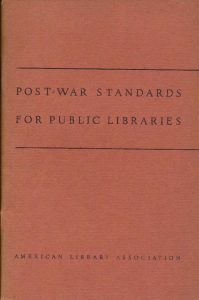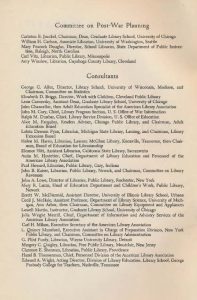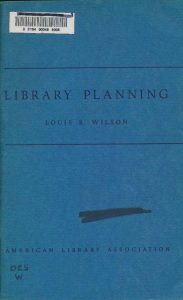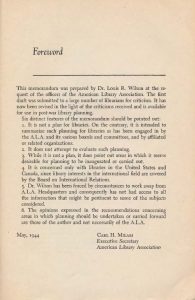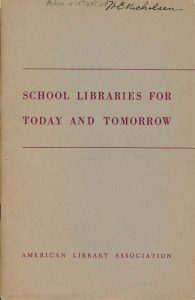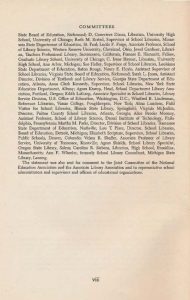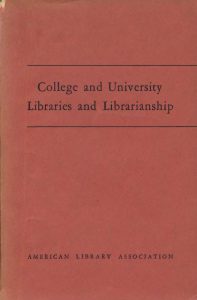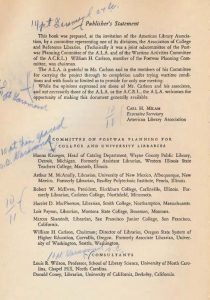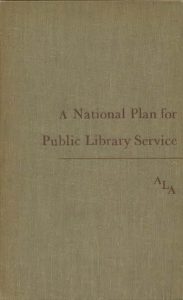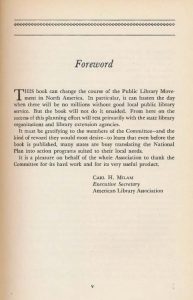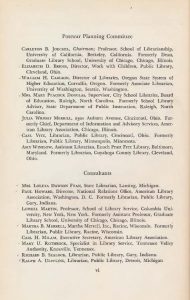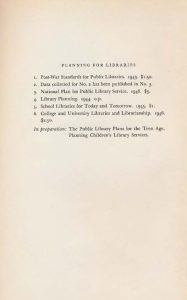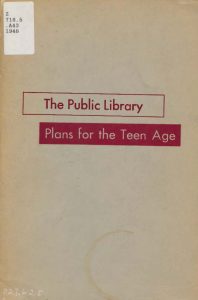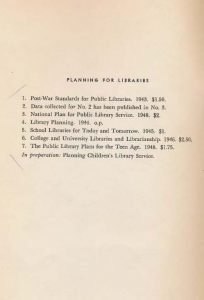From 1943 through 1948, known under the series title Planning for Libraries, the American Library Association produced a series of resources to support library access expansion across the United States following the end of World War Two. Each publication is rich with recommendations and summaries of opportunities available to many public libraries. Read on to learn more about Planning for Libraries!
As A.L.A. Executive Secretary (today’s Executive Director) Carl H. Milam writes in the foreword to Post-War Standards for Public Libraries, the Library Planning series began as a 3-step project. First, the Post-War Standards would be written. Next, the comparison of existing nationwide library services would follow. Finally, a working program for future library service development would be prepared. Over the next few years, this publication series expanded to 7 issues, much beyond the initial scope of the project, resulting in a rich series on U.S. library services plans after the war. In the following descriptions below, each publication will be presented chronologically by publication date because some earlier publications were not completed until later publications were finished.
And so it was at the request of the U.S. National Resources Planning Board, in 1942, and with its financial support, that the first publication of the series was to be the Post-War Standards for Public Libraries which was published in 1943. University of Chicago Graduate Library School Dean (and A.L.A. Committee on Post-war planning Chair) Carleton B. Joeckel planned, directed, and wrote for this project. This 92-page publication features 7 chapters identifying 8 different standards, including standards of (for): library service; government and administration; size and area; finance; buildings; book collections; personnel; and technical processes.
While Number 2 and Number 3 would be combined in Number 3 and printed at a later date, the next released publication was Number 4: Library Planning which was written by another University of Chicago Graduate Library School faculty member (and former head) Louis R. Wilson in 1944. In the foreword (above), the author explains that this 93-page publication is a memorandum concerning a recent history of recent library plans by different library leaders and stakeholders in Canada and the U.S. What the author does not mention (and readers will appreciate) is a helpful 154 citation references list at the end of the publication.
The next publication was Number 4: School Libraries for Today and Tomorrow written by the subcommittee and chaired by North Carolina State Department of Public Instruction School Libraries Director Mrs. Mary Peacock Douglas, published in 1945. This was no ordinary committee, since school libraries serve both user communities who are in schools and who are young, and the subcommittee included members from both the Division of Libraries for Children and Young People (now Association for Library Service to Children) and the American Association of School Librarians too. This 43-page publication features 7 chapters, a bibliography, and an appendix with quantitative standards (measurements) for school libraries and library housing. The chapter topics include standards of (for): the development of school libraries in education; a description of services to pupils and teachers; library personnel; book collections and other library resources; library housing; as well as administration, supervision, and extension work.
That same year, Number 5: College and University Libraries and Librarianship was prepared by the Committee and the Association of College and Reference Libraries (now Association of College and Research Libraries) chaired by Ohio State University Librarian William H. Carlson. Described as a study in the preface, the 152-page publication contains 12 chapters and a bibliography, on standards topics including: library expenditures and standards of support; the books in the libraries; acquisition, organization and use of library materials; cooperation and coordination in the profession; philanthropy and college libraries; characteristics and education of personnel; professional organizations; professional literature; the college library building; government of college libraries; and a conclusion. Curious readers should be sure to read the conclusion for an essay on the strategic opportunities of educated leaders after a disaster, including quotes from librarian William N. C. Carlton, economist and sociologist Thorstein Veblen, and R. B. Fosdick (of the Rockefeller Foundation).
In 1948, Number 2 and Number 3 were published as a combined book Number 3: A National Plan for Public Library Service. Initially, the plan was to publish the data collected as Number 2, and the final national library plan would be published as Number 3. However, the data was not published as planned and it was incorporated into the second chapter of Number 3. This 168-page publication includes 13 chapters and an alphabetical subject index too. The chapters are arranged into three parts. The first part, Chapters 1 to 2, contrasts ideals of library service with the data collected. In the second part, Chapters 3 to 7, a national system of public libraries is proposed. While the third part, Chapters 8 to 12, describes what implementation of a national system would look like, organized by the subject themes of previous volumes (e.g. library collections, personnel, buildings, citizen interest, and research projects).
Also in 1948, Number 7: The Public Library–Plans for the Teen Age was published as a supplement to Number 3 and it was undersigned by both Amy Winslow and Carleton B. Joeckel too. The book’s subcommittee was overseen by New York Public Library Superintendent of Work with Schools and Chair Mabel Williams, with the Division of Libraries for Children and Young People (now the Association for Library Service to Children) and its Section The Young People’s Reading Round Table. This 86-page publication includes 7 chapters and a large, 59-page appendix including excerpts from articles about library work with young people too.
By 1948, after five years of publications, the Library Planning series ended but its content would continue to provide ideas for the future library work after the war. Ambitious projects like these are seldom done in isolation, and this series was another great collaborative project. As seen from each number’s credit pages, nearly all of the plans included the work of multiple A.L.A. committees and many library consultants too.
For half a decade, the Planning for Libraries series, under Chair Carleton B. Joeckel, produced a variety of planning resources for librarians and library administrators alike. Equally as various as the publications themselves, were the library-based collaborators and consultants from across the U.S. in libraries everywhere. For even more information about the Post-War Planning Committee, please see the Post-War Planning Committee Subject File (Record Series 93/10/6) and the Reports and Circulars too (Record Series 93/10/2).
Copies Available at Your ALA Archives
Physical copies of Planning for Libraries are available for viewing at the ALA Archives. Please view the Record Series 93/10/3 database record entry, for more information.
Got Something to Donate to the Story So Far?
Many people have been involved in the long history of A.L.A. publications and national library planning work too. Do you have any information about early publications or national library planning participants, collaborators, publications, or beneficiaries? Please contact us through social media. We and our readers would like to read about it.
